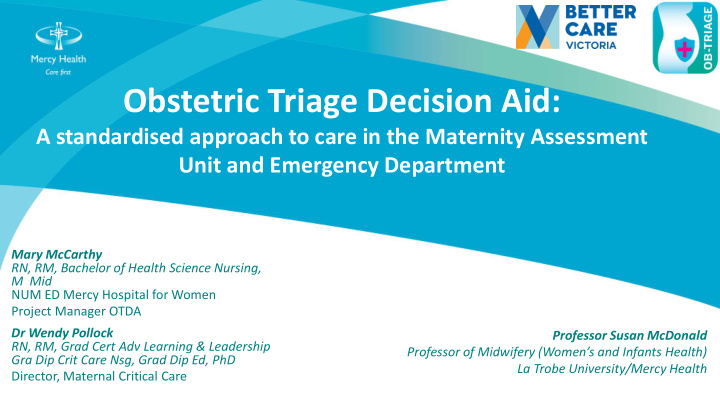



Obstetric Triage Decision Aid: A standardised approach to care in the Maternity Assessment Unit and Emergency Department Mary McCarthy RN, RM, Bachelor of Health Science Nursing, M Mid NUM ED Mercy Hospital for Women Project Manager OTDA Dr Wendy Pollock Professor Susan McDonald RN, RM, Grad Cert Adv Learning & Leadership Professor of Midwifery (Women’s and Infants Health) Gra Dip Crit Care Nsg, Grad Dip Ed, PhD La Trobe University/Mercy Health Director, Maternal Critical Care
Triage • Process to assess a patient’s clinical urgency for treatment • Widely implemented in emergency departments to address access to care, wait times, and resource allocation • Worldwide various triage scales • Australasian Triage Scale- used Australian ED’s
Australasian triage scale (ATS) The ATS is used as a clinical indicator, benchmarking tool and funding mechanism (FitzGerald et al., 2010)
Triage by ED nurses on maternity presentations
Triage of maternity presentations to ED
Midwives capacity to conduct triage
Obstetric triage: What is out there?
Obstetric triage tools Canada • Obstetric Triage Acuity Scale (Smithson et al., 2013) USA • Obstetric Triage Acuity Scale (Paisley et al., 2011) • Association of Women’s Health, Obstetric and Neonatal Nurses (AWHONN) Maternal Fetal Triage Index (Ruhl et al.,2015) England • Birmingham Symptom Specific Obstetric Triage Symptom (Kenyon et al., 2017) Switzerland • Swiss Emergency Triage Scale (Viet-Ruben et al., 2017)
Obstetric triage tools
Obstetric triage tools
The OTDA Background: • MHW ED specialist ED • Required to triage pregnant and post partum women • Application of ATS difficult • In 2012, started developing OTDA using complaint codes in EDIS • Standardised approach in MHW ED – Structured targeted questioning – ATS category generated based on the targeted questioning responses
The project • Implement the OTDA into Werribee Mercy Hospital o General ED o Maternity Assessment Unit • Conduct a validation study of the OTDA
10 Complaint Codes • Abdominal pain in pregnancy at 20 weeks’ or more gestation (including labour) • Chest pain or respiratory problems in pregnancy • Headache in pregnancy at 20 weeks’ or more gestation • Pain and bleeding less than14 weeks’ gestation • Post-partum problems • Per vaginal loss 20 weeks’ or more (bleeding or ruptured membranes) • Reduced fetal movements/concerns for fetal wellbeing > 24 weeks’ gestation • Trauma in pregnancy/ minor blunt abdominal • Unwell in pregnancy less than 20 weeks’ gestation • Unwell in pregnancy at 20 or more weeks’ gestation
Project Overview • Steering group • Local implementation team • Expert consensus group • Staff survey – competence & confidence to triage
Pre observational audit ED & MAU • Clinical audit • ED process mapping • MAU process mapping
Change to MAU process
CHANGES TO THE ED TRIAGE • Identify patient is pregnant first • Use complaint field next • Follow the OTDA
Implementation Pre implementation • One on one training • Redesign of MAU • Feedback • Policies and procedures • Monitoring and auditing • Education and training
MAU ARRIVAL TO TRIAGE TIME 100% 91% 87% 90% 83% 80% 70% 60% PRE TIME TO 50% 40% 30% 20% 14% 10% 10% 3% 1% 0% ≤ 15 min between 16-29 min between 30-60 min greater than 60 min not triaged Pre OTDA Apr-17 May-17 Jun-17 Jul-17 Aug-17 Sep-17 Oct-17 Nov-17 Dec-17 Jan-18 Apr-18 May-18 Jul-18
Was the OTDA used? Was the OTDA valid? Did staff feel more confident & competent? The results slides have been excluded as publication is in progress
Post-implementation audit Total number of presentations (n=3026) • ED (n=718) o 7 August – 5 November 2017 • MAU (n=2308) o Extracted from EDIS in ED and MAU Excluded (n=197) • Neonates • Postpartum > 42 days • No belief the woman was pregnant • Mental health presentations • Planned presentations for non- urgent reasons Number of presentations on which data analyses were conducted ( n=2829 ) • ED (n=708) • MAU (n=2121)
Type of complaint ED only (OTDA used n=515) • About 1/3 of cases were ≥ 20 weeks
Type of complaint MAU only (OTDA used n=1976)
Summary • OTDA is a valid tool for triage of pregnant and post partum women • Reduction in waiting times for women who presented unscheduled to the hospital with a problem in pregnancy • Improved data on patient volume and flow which enabled us to better match organisation resources • OTDA tool use in ED was associated with a reduction in ‘under - triage’, a known clinical risk • Effective change was achieved through physical demonstration, clinical support and data feed back
What's Next • Opportunity scaling in Victorian Maternity services and ED • Forum – ED & Maternity sector, BCV & SCV • Submission to publish Next : Evaluation of OTDA for outcome measures
Acknowledgements • Dr Wendy Pollock - slides • Professor Susan McDonald • OTDA Steering committee • Local implementation team • Midwives and Nurses at WMH • BCV
Recommend
More recommend